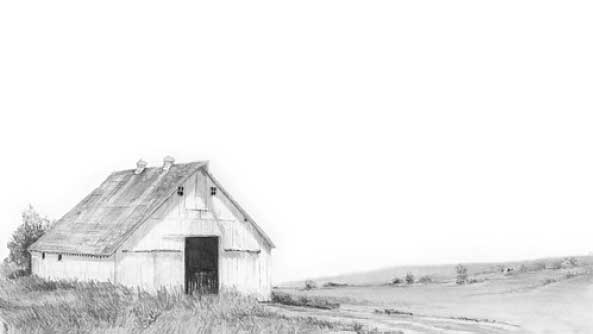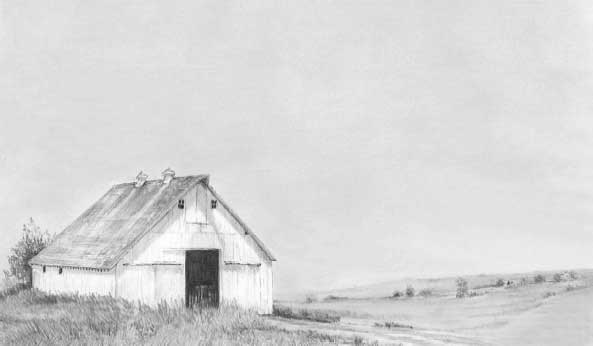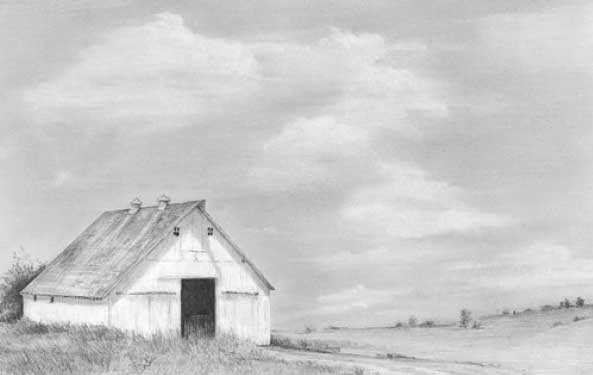Drawing Skies and Clouds
Tutorial by Diane Wright
- part one
- part two
part one
Start by just looking up
Ever since a fellow artist challenged me to include a sky in one of my drawings, I have been keeping my mind in the clouds. I am continually amazed at the beauty of just looking up in the sky! Over the past couple of years, I have been learning the importance of toning the sky and adding clouds as part of overall compositional improvement in my landscapes. I think I could spend hours and hours fiddling with each puff of white!Start looking up to the sky and observe cloud formations. Take photos of clouds and you will be amazed at what you will start to “see”!
What’s the purpose of a sky?
Is it important to put a sky in? There aren't any clouds in the sky so why should I shade it? I use to think this and if you visit my website, you will see many of my earlier works did not include a toned sky. For a long time I didn't even "see" tone in the sky. It wasn't until recently that I realized the impact of adding a toned sky to the overall landscape. Here are some of the things a toned sky will do for your drawing:- Broadens the range of tones available in your drawing. The white of the paper can now represent the highlights only.
- Creates uniformity to your drawing composition.
- Adds an additional sense of reality to your landscape.
- Adds atmosphere and sets the "mood" of the scene.
In the following series of drawings, which illustrate the importance of a toned sky and why the sky and clouds should be considered in the overall compositional study of any landscape, I've chosen a very simple scene with a white barn - my only variable is the inclusion of a sky and clouds.

This first image is the drawing without a sky. It is very stark and the sky (the white of the paper) is competing with the white of the barn.

The second image is much improved by adding a toned sky. The white barn is now the focal point, as the toned sky accentuates and brings the entire scene together much better.

The third image incorporates a toned sky as well as including clouds. The clouds add depth to the scene as they recede into the distance. They also create a visual directional flow for the viewer. The clouds lead the eye through the drawing and add interest as well.

This first image is the drawing without a sky. It is very stark and the sky (the white of the paper) is competing with the white of the barn.

The second image is much improved by adding a toned sky. The white barn is now the focal point, as the toned sky accentuates and brings the entire scene together much better.

The third image incorporates a toned sky as well as including clouds. The clouds add depth to the scene as they recede into the distance. They also create a visual directional flow for the viewer. The clouds lead the eye through the drawing and add interest as well.
Cloud Formations and Cloud Types
- Stratus - Wispy light clouds
- Cumulus – white puffy…cottony
- Dramatic – rain clouds - thunderheads
- Back lit clouds - sunsets
TIPS
- Skies are lighter at the horizon and go darker as you go up the sky.
- Clouds use perspective – smaller and tighter the farther in the distance they are.
- Unless the sky is the central part of the drawing, light wispy or under-stated clouds work well.
- Use clouds to lead the viewer through your landscape.
- Clouds have form and are three-dimensional – they don't have any lines or hard edges.
- The more dramatic clouds – the darker the base tone should be (this allows more range of tones).
Drawing Materials:
This is a very specific list of the materials that I use. Substitutions can certainly be used. Experimentation and adjustments are expected to customize these techniques to your style of drawing.- 0.5 mm Mechanical Pencils F and 2H lead
- Chamois
- Tortillon - small
- Blu-Tack
- Small Ruler or T-square
- Strathmore 300 Series Bristol Board
- Make-up brush
- part one
- part two




